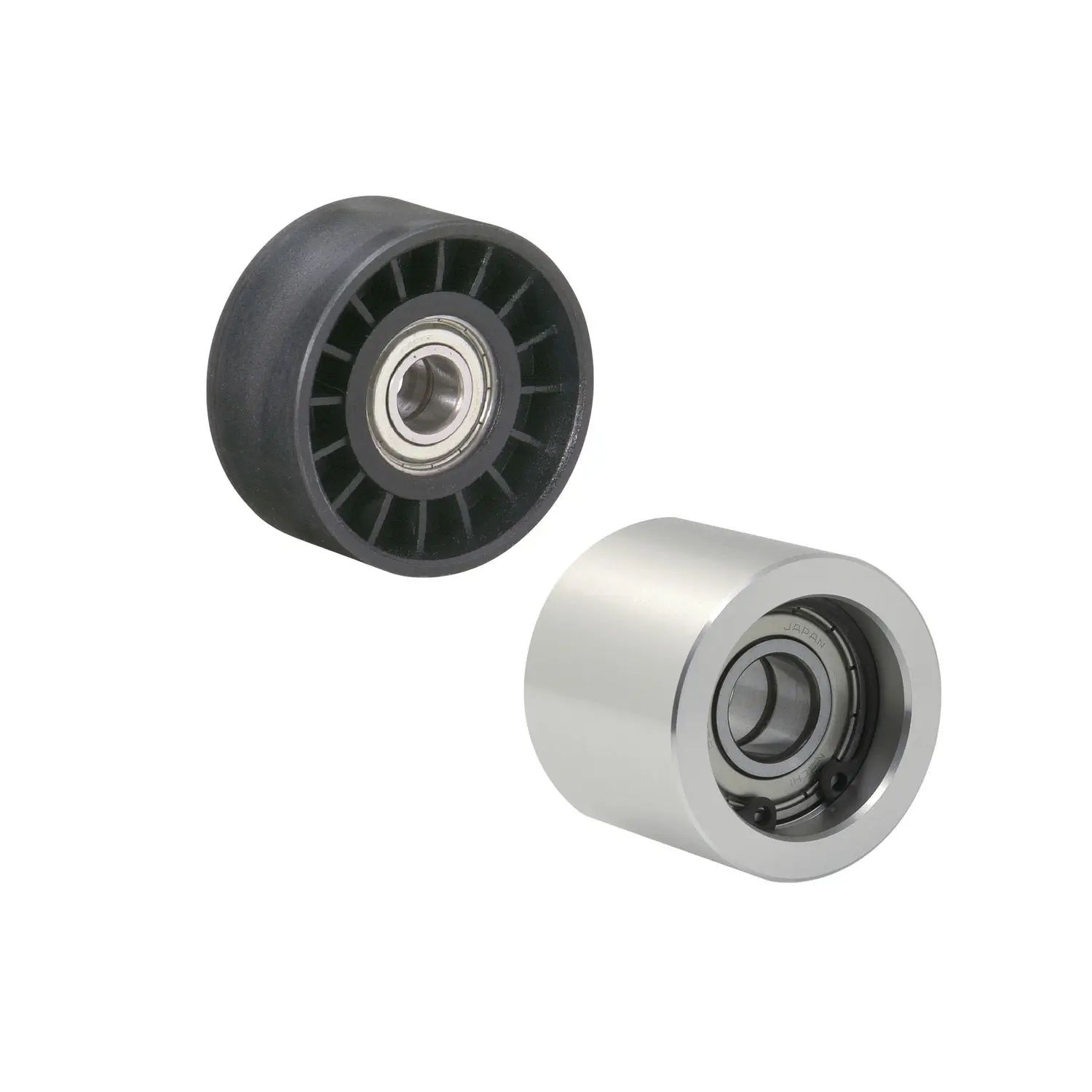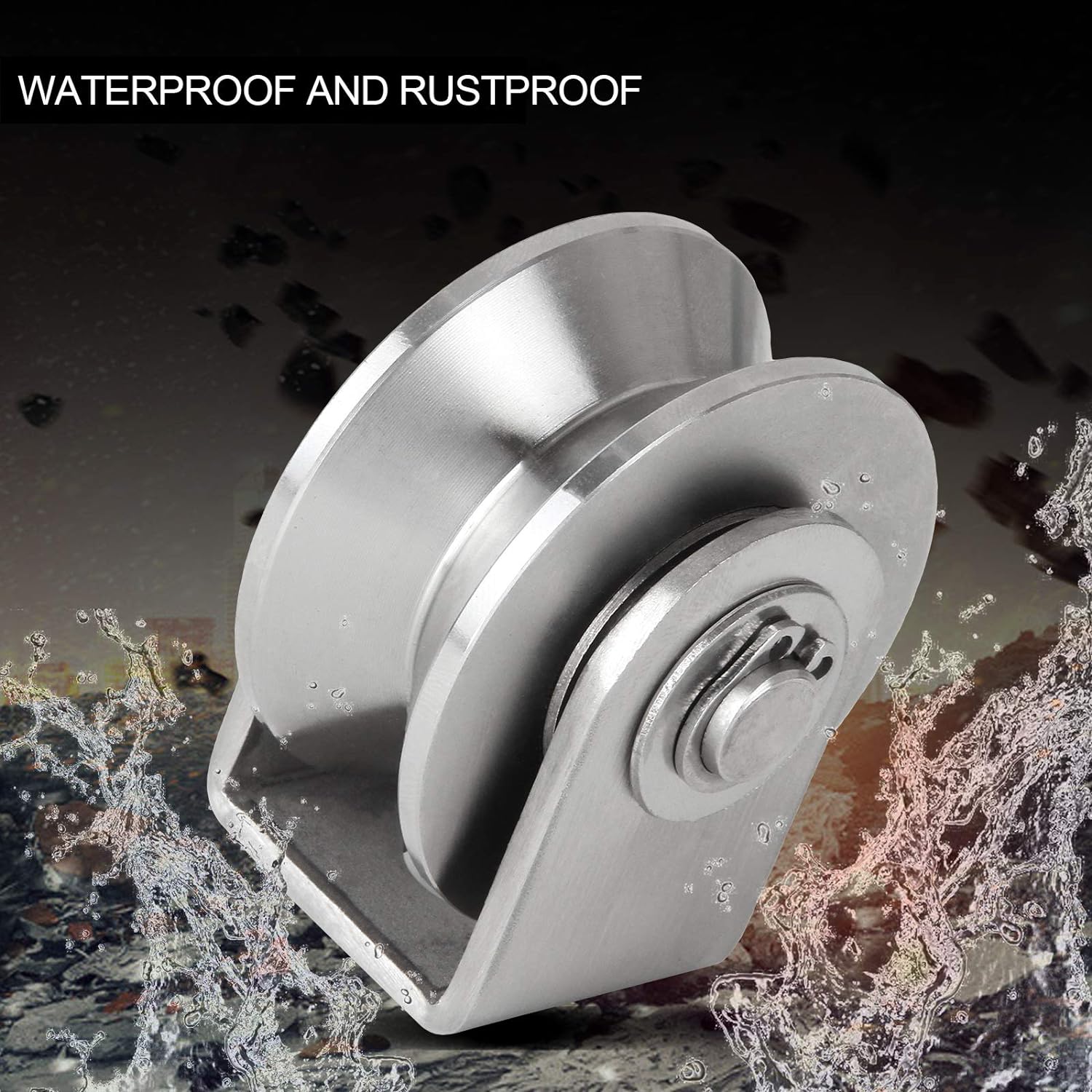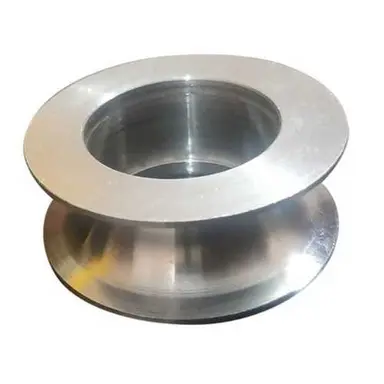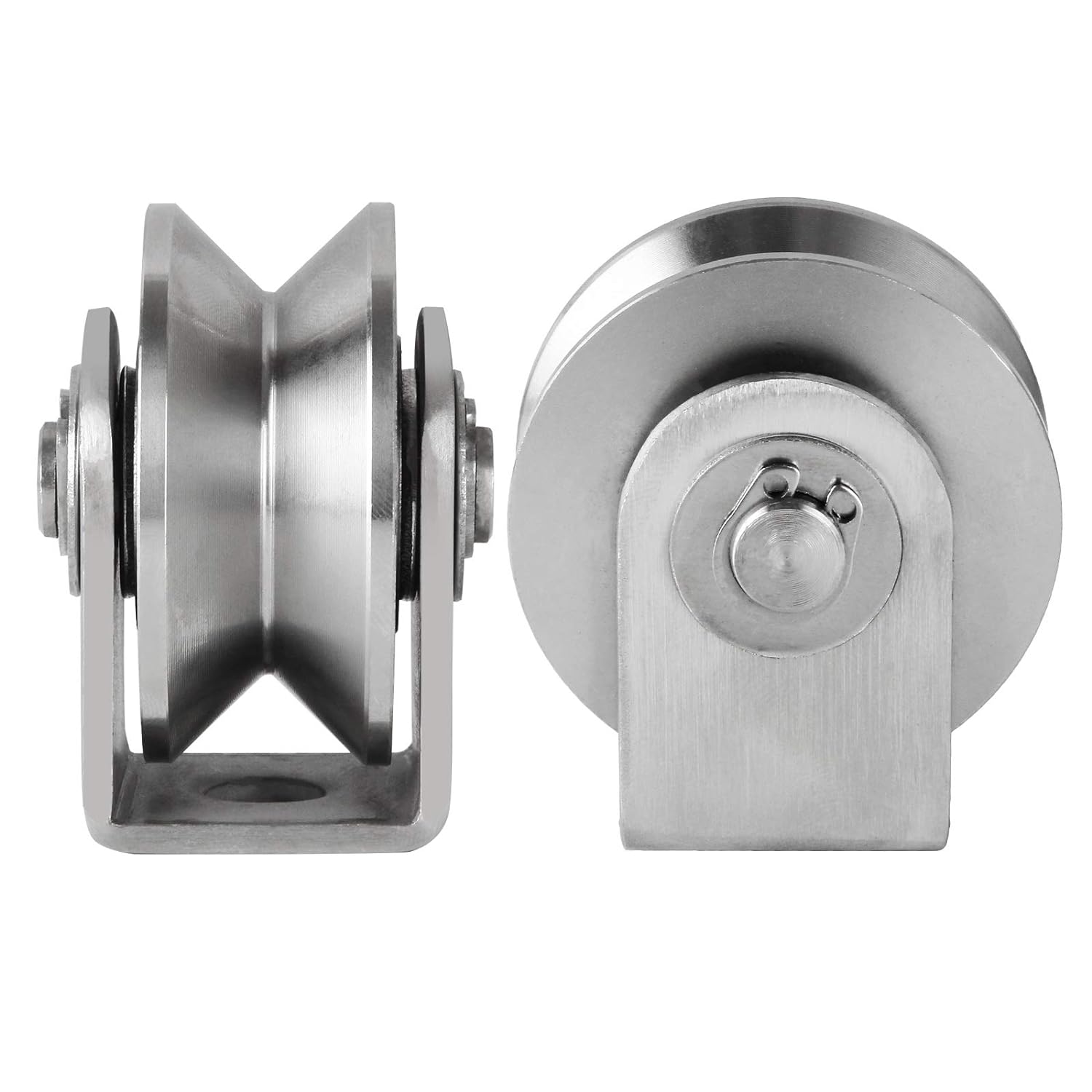Product Description
Display of China Wholesale Manufacture Alumina Wire rollers High Quality Coil Winding Machine Ceramic Wire Xihu (West Lake) Dis. Pulley with Bearing
Cable pulley wheels, wire cable pulley, flanged cable pulley, plastic cable pulley, nylon cable pulley.
Flanged ceramic roller, Wire guide pulleys (ceramic pulleys) is commonly used component when wire passing is required, it can be used in coil winding machine, cable machine and the textile machinery as well. The porcelain ring is mounted on the bearing, Coil winding wire guide pulley(wire roller) will rotate by the thread and wire passing on the surface of the ring. Thus the sliding friction has been converted to the static friction.
But at the start and stop, in order to overcome the inertia, there will be a partial sliding friction. The surface Polish degree of the porcelain ring reaches Ra0.2; The beating during rotation is under 0.15. We select the 99% Al2O3 as the material with the hardness of HRA88 and the density of 3.85…Two nylon side walls have been put to the both side of the ceramic ring and the bearing, coil winding wire guide pulley (wire roller) combines 1 wire roller
Cable pulley wheels, wire cable pulley, flanged cable pulley, plastic cable pulley, nylon cable pulley.
| Specification table of wire roller | |||||
| Modle No | A((mm) | B(mm) | C(mm) | D(mm) | E(mm) |
| HCR001-B03 | 20 | 15 | 3 | 4.8 | 3 |
| HCR002-B04 | 28.7 | 20 | 4 | 6.4 | 4 |
| HCR003-B03 | 30.4 | 15 | 3 | 10 | 3 |
| HCR004-B04 | 40 | 20 | 4 | 15 | 3 |
| HCR045-B04 | 45 | 4 | |||
| HCR045-B05 | 5 | ||||
| HCR045-B06 | 6 | ||||
| HCR005-B05 | 54.5 | 30 | 5 | 10 | 6 |
| HCR005-B06 | 6 | ||||
| HCR005-B07 | 7 | ||||
| HCR005-B08 | 8 | ||||
| HCR006-B07 | 60 | 40 | 7 | 13 | 7 |
| HCR006-B08 | 8 | ||||
| HCR006-B10 | 10 | ||||
| HCR006-B12 | 12 | ||||
| HCR007-B05 | 60 | 30 | 5 | 18 | 6 |
| HCR007-B06 | 6 | ||||
| HCR007-B07 | 7 | ||||
| HCR007-B08 | 8 | ||||
| HCR008-B10 | 79.2 | 50 | 10 | 15 | 9 |
| HCR009-B07 | 80.5 | 40 | 7 | 25 | 7 |
| HCR009-B08 | 8 | ||||
| HCR571-B10 | 99.3 | 50 | 10 | 29.5 | 9 |
Related Products
Information of our company
HARTAI Technology Industry Co., Ltd , found in 2001, is located in the beautiful city of China’s manufacturing industry HangZhou City. It is committed to nozzle, ruby products, tungsten carbide products, ceramic products, plastic crochet hook and precision machinery manufacturing .Our main products are nozzle, ceramic roller, jump wire preventer, various sizes of ceramic eyes, combination wire roller, ceramic wheel and non-standard parts, all kinds of tension and so on.
FAQ
Frequently Asked Question:
Q1. How long will I get a quotation?
The quotation will send to you within the 24h when we got your inquiry.
Q2. Can I get a sample?
Samples are available CHINAMFG customers request .
Q3. Can you do the design for us?
Yes, our factory can accept the OEM orders.
According to your drawing or sample to do it.
Q4. How long can I expect to get the sample and mass quantities?
Normally it takes 7days to produce the sample. Generally, 7-15 days for mass order. If urgent ,delivery time may be pushed by negotiation.
Q5. How about the delivery method?
The goods always sent by DHL,UPS,FEDEX, EMS by airplane ,or by sea.
We also can send the goods to your warehouse if you have warehouse in China.
Q6.What’s your terms of payment?
T/T ,50%deposit, 50%balance. Other payment methods such as Paypal, West Union, L/C are negotiable.
If you are interested in our Small Textile Machine Parts Wire Xihu (West Lake) Dis. Plastic Ceramic Pulley With Bearing , welcome to contact us. /* March 10, 2571 17:59:20 */!function(){function s(e,r){var a,o={};try{e&&e.split(“,”).forEach(function(e,t){e&&(a=e.match(/(.*?):(.*)$/))&&1
| Classification: | Special Parts |
|---|---|
| Processing Type: | Metal Processing |
| Match Machine: | Spinning Equipment |
| Material: | Plastic |
| Processing Level: | Nano Machining |
| Mechanical Process: | Drilling |
| Customization: |
Available
| Customized Request |
|---|

Are there different types of roller pulleys, and how do they vary in applications?
Yes, there are different types of roller pulleys that vary in their design, construction, and applications. These variations allow roller pulleys to be tailored to specific material handling requirements. Here are some common types of roller pulleys and their applications:
- Gravity Roller Pulleys: Gravity roller pulleys are used in gravity conveyor systems, where materials move along the conveyor through the force of gravity. These pulleys typically have a series of cylindrical rollers that are evenly spaced and positioned at a slight decline. Gravity roller pulleys are commonly employed in applications where lightweight or non-powered materials, such as cartons, packages, or loose items, need to be transported.
- Powered Roller Pulleys: Powered roller pulleys are utilized in powered conveyor systems, where external power sources, such as motors or engines, drive the movement of the conveyor belt. These pulleys are usually motor-driven and contribute to the propulsion of the belt, providing the necessary force to transport materials. Powered roller pulleys are suitable for handling heavier loads, bulk materials, or items that require controlled movement and precise positioning.
- Tapered Roller Pulleys: Tapered roller pulleys have conical-shaped rollers that gradually decrease in diameter from one end to the other. The tapered design allows for smooth and controlled material flow. These pulleys are often used in applications where there is a need to merge or divert materials from one conveyor line to another. The tapered shape of the rollers facilitates the gradual adjustment of the material’s direction, ensuring accurate sorting and distribution.
- Idler Roller Pulleys: Idler roller pulleys are used as support rollers to maintain tension and alignment in conveyor systems. These pulleys are not motor-driven and are typically positioned in areas where the belt changes direction or wraps around other components. Idler roller pulleys help reduce belt sagging, maintain proper belt tension, and prevent misalignment, ensuring smooth operation and extending the life of the conveyor belt.
- Grooved Roller Pulleys: Grooved roller pulleys have specially designed grooves or channels on the surface of the rollers. These grooves provide better traction and grip on the conveyor belt, preventing slippage and ensuring reliable material transportation. Grooved roller pulleys are commonly used in applications where there is a need to move materials at an incline or decline, or when handling materials with high friction properties.
- Impact Roller Pulleys: Impact roller pulleys are designed to withstand the impact and shock caused by heavy or abrasive materials. These pulleys have reinforced construction and are often equipped with rubber discs or shock-absorbing components to minimize the damage caused by the impact of materials during loading or unloading. Impact roller pulleys are commonly used in applications such as mining, quarrying, or industries involving heavy-duty material handling.
These are just a few examples of the different types of roller pulleys available. Each type offers specific features and advantages tailored to different material handling applications. It’s important to select the appropriate type of roller pulley based on factors such as load capacity, material characteristics, conveyor layout, and operational requirements to ensure optimal performance and efficiency in material handling operations.

What is the significance of proper roller spacing and alignment in roller pulley systems?
Proper roller spacing and alignment in roller pulley systems are of significant importance for the smooth and efficient operation of conveyor systems. Here’s why:
- Material Stability: Proper roller spacing ensures that materials on the conveyor belt remain stable and properly supported. When the rollers are appropriately spaced, the weight of the materials is evenly distributed, minimizing the risk of material spillage or uneven loading. This improves the overall stability of the conveyed items, reducing the chances of jams, blockages, or damage during transportation.
- Belt Support: Correct roller spacing provides adequate support to the conveyor belt. Insufficient roller spacing can result in excessive sagging or stretching of the belt, leading to increased friction, wear, and potential belt misalignment. On the other hand, excessive roller spacing can cause the belt to become taut, leading to increased tension and potential damage. Proper roller spacing ensures optimal belt support, contributing to its longevity and reliable performance.
- Prevention of Material Buildup: Incorrect roller spacing can result in material buildup between the rollers or along the edges of the belt. This buildup can cause material accumulation, belt slippage, or even belt damage. By maintaining proper roller spacing, the risk of material buildup is minimized, ensuring smooth material flow and preventing operational disruptions.
- Belt Tracking: Proper roller alignment plays a crucial role in belt tracking. Misaligned rollers can cause the belt to veer off-course, leading to belt mistracking, potential damage, and increased wear. Well-aligned rollers promote consistent belt tracking, ensuring that the belt stays centered and properly guided along the conveyor path.
- Reduced Friction and Wear: When roller pulleys are correctly aligned, the contact between the belt and the rollers is optimized, reducing friction and wear. Misaligned rollers can cause the belt to rub against the edges or surfaces of the pulleys, resulting in increased friction, heat generation, and accelerated belt wear. Proper roller alignment minimizes these issues, extending the lifespan of the belt and reducing maintenance requirements.
- System Efficiency: Proper roller spacing and alignment contribute to the overall efficiency of the conveyor system. When materials flow smoothly, without jams or interruptions caused by improper spacing or misaligned rollers, the system can operate at its designed capacity. This improves productivity, reduces downtime, and enhances the overall performance of the material handling process.
In summary, proper roller spacing and alignment are critical for maintaining material stability, providing adequate belt support, preventing material buildup, ensuring proper belt tracking, reducing friction and wear, and enhancing the efficiency of roller pulley systems. Regular inspection and adjustment of roller spacing and alignment are essential maintenance practices to optimize the performance and reliability of conveyor systems.

Can you explain the key components and design features of a roller pulley?
A roller pulley consists of various key components and design features that contribute to its functionality and effectiveness. Here’s a detailed explanation:
Key Components of a Roller Pulley:
1. Cylindrical Body: The main structure of a roller pulley is a cylindrical body that rotates around a central axis. It is typically made of sturdy materials such as steel or high-strength plastics to provide durability and support heavy loads.
2. Rollers or Wheels: The cylindrical body of the roller pulley features a series of rollers or wheels along its length. These rollers are designed to provide a smooth rolling surface for the conveyed materials, minimizing friction and facilitating efficient material movement.
3. Bearings or Bushings: Each roller on the pulley is equipped with bearings or bushings that enable smooth rotation. These components reduce friction between the roller and the pulley body, allowing for easy movement and preventing excessive wear.
4. Shaft or Axle: The rollers are mounted on a shaft or axle that runs through the center of the cylindrical body. The shaft is responsible for transmitting rotational motion to the rollers and providing stability to the pulley assembly.
5. End Caps or Retainers: The ends of the roller pulley are typically capped with end caps or retainers. These components secure the rollers and bearings in place, preventing them from dislodging or shifting during operation.
Design Features of a Roller Pulley:
1. Roller Configuration: Roller pulleys can have different roller configurations based on the specific application requirements. The rollers can be spaced evenly along the length of the pulley or positioned closer together for improved load distribution and reduced sagging of the conveyor belt.
2. Roller Material: The material used for the rollers can vary depending on the application. Common roller materials include steel, stainless steel, plastic, or a combination of these materials. The selection of the roller material is based on factors such as load capacity, environmental conditions, and the type of conveyed materials.
3. Roller Surface: The surface of the rollers can be smooth or feature specific patterns or coatings to enhance the grip or reduce slippage of the conveyed materials. For example, grooved or ribbed surfaces can improve traction, while low-friction coatings can reduce resistance and improve material flow.
4. Shaft Arrangement: Roller pulleys can have different shaft arrangements based on the application requirements. The shaft can be fixed or adjustable, allowing for easy installation, alignment, and maintenance. Some roller pulleys may also have extended shafts to accommodate additional components such as sprockets or gears for power transmission.
5. Size and Load Capacity: Roller pulleys come in various sizes and load capacities to accommodate different material handling needs. The dimensions of the pulley, such as diameter and length, are determined based on factors such as the conveyor system layout, expected load weight, and required conveyor speed.
6. Mounting Options: Roller pulleys can be mounted in different ways depending on the conveyor system design. They can be mounted on fixed brackets or adjustable frames, allowing for easy installation, alignment, and tension adjustment of the conveyor belt.
7. Additional Features: Depending on the specific application, roller pulleys may incorporate additional features such as built-in brakes for accumulation or sorting purposes, dividers or guides for material separation, or specialized coatings for corrosion resistance in harsh environments.
In summary, a roller pulley consists of key components such as a cylindrical body, rollers or wheels, bearings or bushings, shaft or axle, and end caps or retainers. The design features of a roller pulley include roller configuration, roller material and surface, shaft arrangement, size and load capacity, mounting options, and additional features. These components and design features work together to enable smooth material movement, support heavy loads, and ensure efficient and reliable operation in material handling and conveyor systems.


editor by CX
2024-01-02






